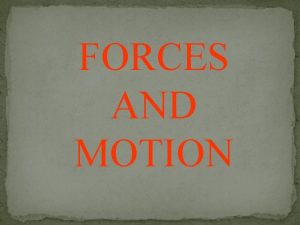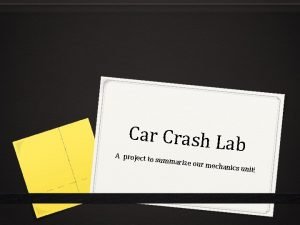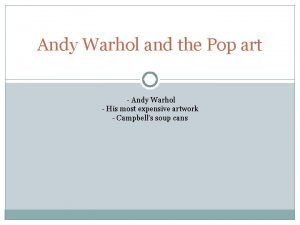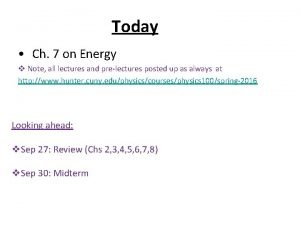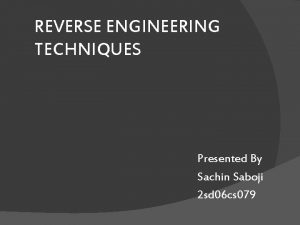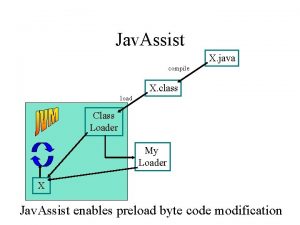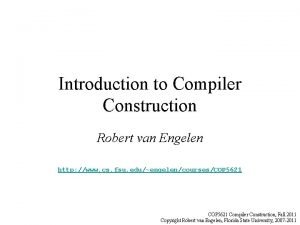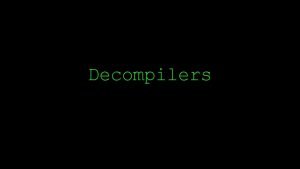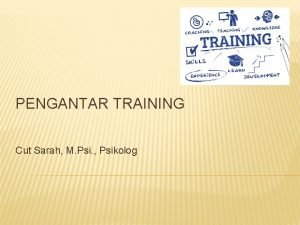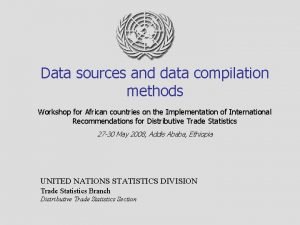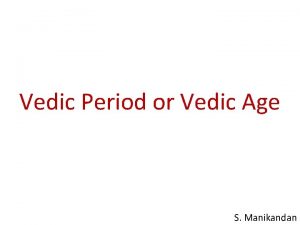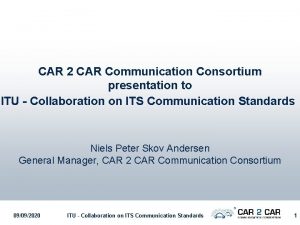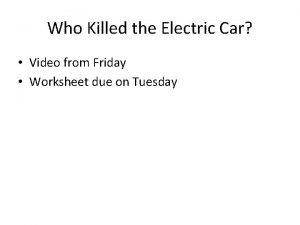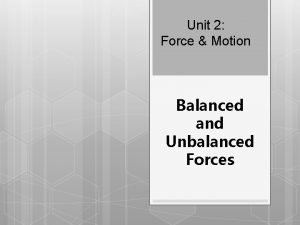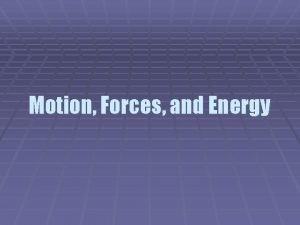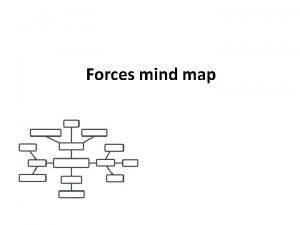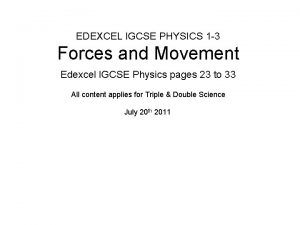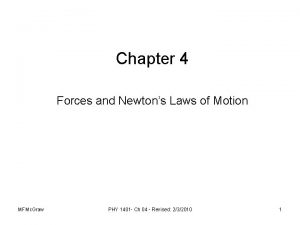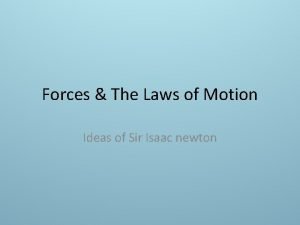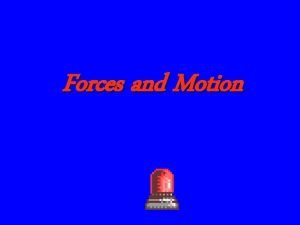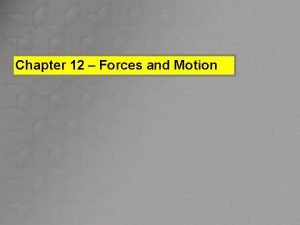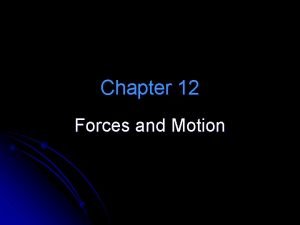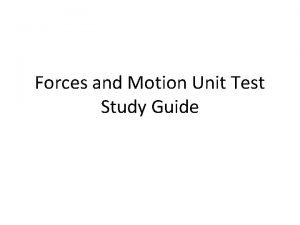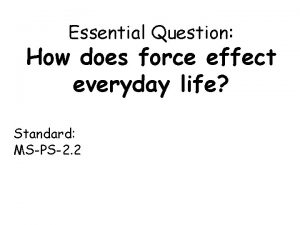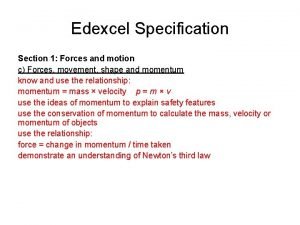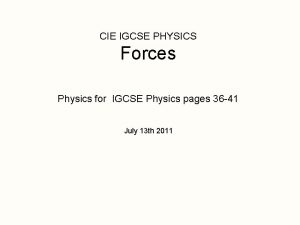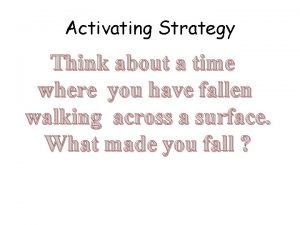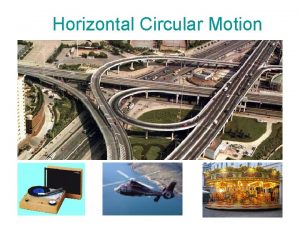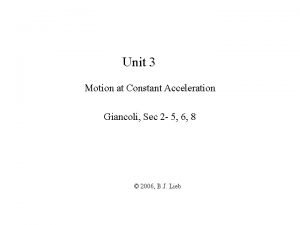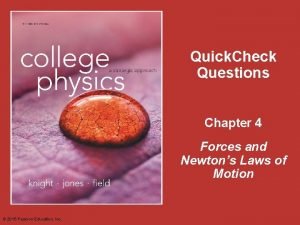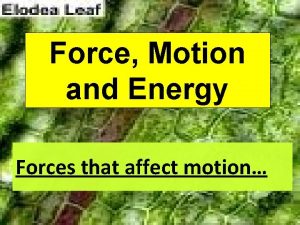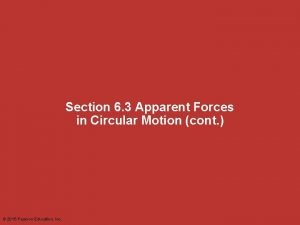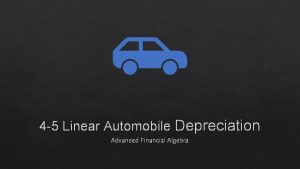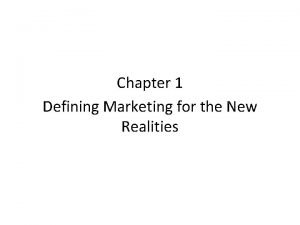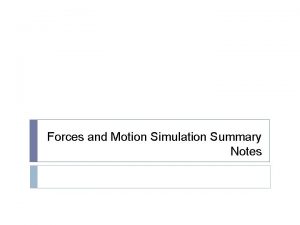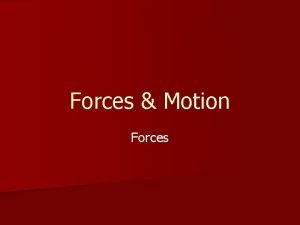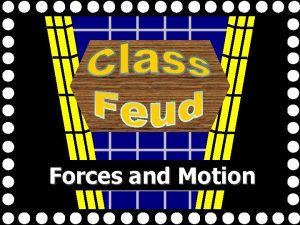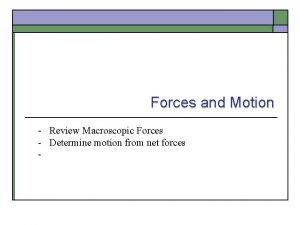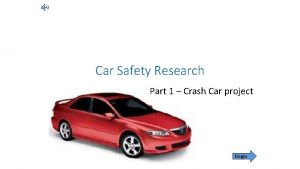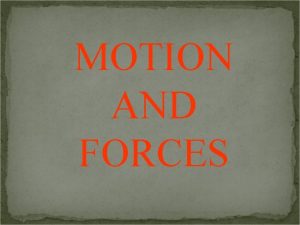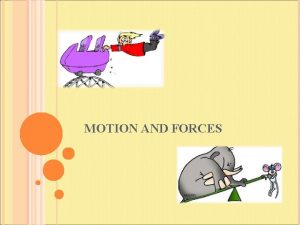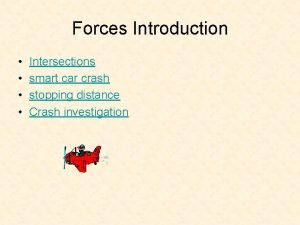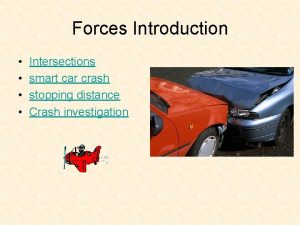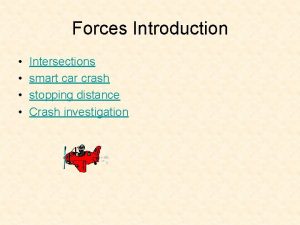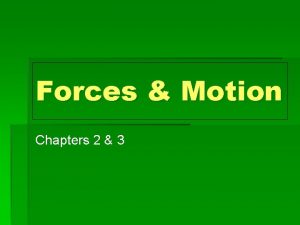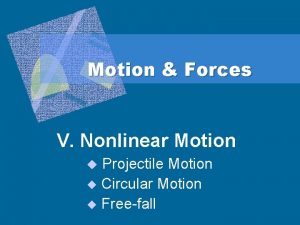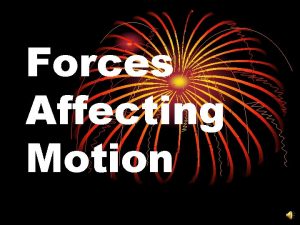FORCES AND MOTION New Car Crash Compilation Video








































































- Slides: 72

FORCES AND MOTION

New Car Crash Compilation Video 2011 Youtube http: //www. youtube. com/watch? v=jko 6 qzs. Ovgg

WHAT IS A FORCE? A force is simply a push or a pull. THERE IS A BIG RELATIONSHIP BETWEEN FORCE AND MOTION WITHOUT A FORCE THERE WOULD BE NO MOTION.

Forces v. What types of forces can you think of? v. How is the object affected by those forces?

Examples of forces acting on objects would be: A flag being blown by the force of the wind. A jet engine propelling an airplane forward. Iron being pulled toward a magnet.

Examples of forces acting on objects would be: Opening and closing a door. A space shuttle lifting off

What type of force would these objects need to move? Sports equipment kites wagons sleds

FORCES ALWAYS OCCUR IN PAIRS Forces give an object the energy to move, stop moving, or change direction.


Vocabulary Instructions Make a Frayer’s Model Box for EACH of the words below: 1. Force 2. Net Force 3. Unbalanced Force 4. Balanced Force 5. Friction 6. Motion 7. Reference Point 8. Speed 9. Average Speed 10. Velocity 11. Acceleration

Net Force Total amount of force acting on an object. Will also determine motion and direction of motion.

Net Force Total amount of force acting on an object. Will also determine motion and direction of motion.

Net Force The total amount of forces acting on an object. When the forces are acting in the opposite direction you subtract the forces.

Net Force Total amount of force acting on an object. When forces are acting in the same direction you add the forces together to get the net force.

HOW DOES FORCE CAUSE MOTION? Motion is a result of UNBALANCED FORCES. UNBALANCED FORCE is when the net force on an object is greater than 0.

HOW DO UNBALANCED FORCES CAUSE MOVEMENT? REMEMBER: Forces always come in pairs. 2 Unbalanced forces acting in the same direction get added together and cause motion.

EXAMPLES OF UNBALANCED FORCES PUSHING A SHOPPING CART SKIING DOWNHILL

WHAT IS A BALANCED FORCE? Balanced Forces cause no motion. = when the net force on an object is zero. The paired forces occur in opposite directions and are of equal force.

EXAMPLES OF BALANCE FORCE There is an equal amount of people playing tug of war.

WHICH PICTURES SHOW BALANCED FORCE? WHICH PICTURES SHOW UNBALANCED FORCE?


FRICTION : FORCE THAT OPPOSES MOTION Friction - The force that opposes motion between two surfaces. v Friction occurs because all surfaces are covered with microscopic hills and valleys, which make the surface rough. When surfaces touch, the hills and valleys stick to each other and this causes friction even if the surfaces look smooth.

Humans have tiny ridges in their hands and feet which increase the amount of friction. This allows us to clasp objects and avoid slipping. Tires are designed to increase friction on the road. HOW DO THEY DO THIS?

FACTORS THAT AFFECT THE AMOUNT OF FRICTION 1. Roughness - The more rough the surface; more friction created. 2. Force - The more force pushing the object; the more friction between valleys. 3. Attraction between objects(static) - The greater the attraction; the more friction created.

Would you rather catch a ball diving in the grass or on concrete? Why do ice skates only have a small blade? Why put oil in your car? Why can’t you open a jar with lotion on your hands? All of these questions deal with friction !!!!!

v The rougher the surface, the ____ the friction. v If the force is increased, the hills and valleys of the surfaces can come in closer contact so friction is ________. v Less massive objects exert less force on surfaces than more massive objects so friction is _______.

TYPES OF FRICTION 1. Sliding Friction 2. Rolling Friction 3. Fluid Friction

SLIDING FRICTION Definition - Friction caused by objects sliding across one another. Examples - Pushing an object (dresser), sledding, brakes, chalk

ROLLING FRICTION Definition - Friction produced by objects such as wheels or ball bearings. Examples - Wheels are placed under objects to reduce sliding friction. Cars, moving large objects with dollies,

FLUID FRICTION Definition - Force exerted by a fluid(gas and liquids). Examples - Water, oil, and air. Sliding friction is usually changed to fluid friction by adding lubricants. Why is it on a slick floor?

STATIC FRICTION Definition - When a force is applied, but the object does not move. Examples - Block and a table. Block will move when the force is large enough to overcome the friction.

WAY FRICTION IS HELPFUL 1. 2. 3. 4. Push against car to make it move. Brakes to stop objects. Between pencil and paper. Friction between floor and feet.

WAYS FRICTION CAN BE HARMFUL 1. Friction in the engine causes temperature to rise. 2. Wind and water causes erosion. 3. Holes in you jeans. 4. Hard to move heavy objects.

WAYS TO REDUCE FRICTION 1. 2. 3. 4. Lubricant(liquid or gas) Wheels Ball bearings Make surfaces that rub against each other smoother.

WAYS TO INCREASE FRICTION 1. Make surface rougher(sand on ice or batters glove). 2. Increase the force pushing the surfaces together.

Name the different types of friction. Give examples of each.

Name two ways friction is helpful and harmful.

Name two ways to overcome friction.

WHAT IS MOTION? Motion is a change in an objects position over time when compared with a reference point.

Reference point or frame of reference is the background or object that appears to stay in place when compared to an object being observed in motion. ***Most common reference point is the Earth’s surface. *** Other reference points are buildings, trees, mountains etc. What reference point do the balloonists use?

Reference Point

Motion is not absolute, it depends on the observer. For example, if Jack and Jill are sitting in a bus, Jack sees Jill at rest and Jill sees Jack at rest. BUT, if we zoom out, we see that Jack and Jill are sitting on a bus moving at a constant speed of 25 mph. From the reference INSIDE the bus, Jack sees Jill at rest and Jill sees Jack at rest.

Jill’s mother, waiting for the bus, sees Jill’s bus go by at 25 mph. She sees Jill traveling 25 mph. Jack on the other hand, still sees Jill as going 0 mph. What they observe seems to depend on their reference point.

While riding the bus, Jill begins throwing cookies to Jack. Jill can throw cookies at a speed of 30 mph. From their reference point, Jack and Jill both see the cookies going 30 mph.

As Jill’s mom observes the cookie tossing from where she is standing on the side of the road, she sees the cookies going 30 mph on a bus moving 25 mph in the same direction. SO, she observes the cookies going 55 mph!!!!!!

As Jill continues to throw 30 mph cookies at Jack, the bus drives by Jack’s mom on a bicycle. She is riding 10 mph in the same direction as the bus is traveling 25 mph. From her point of reference, Jack seems to only be going 15 mph (25 mph – 10 mph) and she see the tossed cookies going 45 mph (15 mph + 30 mph).

As the cookie tossing between Jack and Jill continues, a car drives by going 40 mph in the other direction. The observer in the car sees Jack going 65 mph (40 mph + 25 mph). The observer then notices the flying cookies to be traveling a whopping 95 mph!!!!!! (40 mph + 25 mph + 30 mph).

Types of Motion Projectile Motion: the curved path an object follows when thrown near the surface of the Earth.

Types of Motion Centripetal Motion: when an object moves in a circular path. Ex: Moon in centripetal motion as it revolves around the Earth.

SO WHAT IS SPEED? Speed is the rate at which an object moves. This is determined by the distance traveled and the time it takes to travel. SO… SPEED = DISTANCE / TIME UNITS FOR SPEED: meters per sec (m/s) miles per hour (mi/hr), feet per sec (ft/s)

SOLVE THIS PROBLEM While on vacation, Lisa traveled a total distance of 440 miles. Her trip took 8 hours. What was her average speed?

SOLVE THIS PROBLEM While on vacation, Lisa traveled a total distance of 440 miles. Her trip took 8 hours. What was her average speed? SPEED = DISTANCE/TIME OR SPEED = D/T DISTANCE – 440 MILES TIME – 8 HRS SPEED – 55 MILES PER HOUR

AVERAGE SPEED VS CONSTANT SPEED Average Speed = Total distance traveled divided by Total time of the trip

AVERAGE SPEED VS CONSTANT SPEED Constant speed – speed that does not change. Every plot point on the graph has the same speed When you see a graph like this, you will know that the object is traveling at a constant speed. Double check yourself by calculating the speed at each point.

Which graph shows constant speed?

VELOCITY Velocity is the speed of an object in a specific direction. Speed and Velocity do not mean the same thing Velocity changes as speed or direction changes.

Which of the following are examples of velocity? 1. 25 m/s forward 2. 1/500 km/h 3. 55 m/h south 4. 10, 000 m/s X X

COMBINING VELOCITIES 2 velocities in the SAME DIRECTION – add them together to find the resultant velocity. 2 velocities in DIFFERENT DIRECTIONS – subtract the smaller velocity from the larger velocity to find the resultant velocity.

Acceleration is the rate at which velocity changes. SO…. . if an object speeds up, slows down or changes direction, it has ACCELERATED.

SO… what about this? What type of motion does it have? Is the object accelerating?

Is the object changing speed? NO! Is the object changing direction? YES!!!! An object traveling in a circle is constantly changing direction. SO… is the object accelerating?

Objects that are continuously accelerating is called CIRCULAR MOTION. This means that the direction is constantly changing.

LET’S PRACTICE

1. Consider a car moving with a constant velocity of 10 m/s for 5 seconds. Look at the data table and draw a graph of the results into your notes. Does your graph look like this? What kind of graph is this? What is the speed? The object is traveling at a constant speed of 10 m/s for 5 seconds.

2. Consider a car moving with a constant velocity of 5 m/s for 5 seconds, stopping abruptly, and then remaining at rest for 5 seconds. Graph the information into your notes. Does your graph look like this? Whenever there is a flatline, this means motion has stopped.

3. Look at the picture and graph the information. Does your graph look like this? What is the speed? Graphs that look like this always show ……. ACCELERATION Speed is NOT the same at every point along the line

Drag Car 1 traveled 240 m in 12 sec. Its average speed was 20 m/s. I know it traveled at a constant speed because of the diagonal line on the graph and the fact that the speed was the same at every point along the graph.

Drag Car 2 traveled 150 m in 12 sec. Its average speed was 12. 5 m/s. I know the car accelerated for the first 9 sections of the race and then came to an abrupt stop at 10 seconds and remained stopped for the remainder of the race.

Drag Car 3 traveled 112 m in 12 sec. Its average speed was 9. 3 m/s. This car accelerated throughout the entire race going faster at the beginning but very slowly at the end.

Drag Car 4 traveled 315 m in 12 secs. Its average speed was 26. 3 m/s. Car 4 accelerated for the first two seconds and then came to an abrupt stop. It stayed still for 3 seconds. It started moving again and accelerated very rapidly until the end of the race.

THINK ABOUT RIDES IN AN AMUSEMENT PARK 1. WHICH RIDES HAVE CONSTANT SPEED? 2. WHICH RIDES HAVE CIRCULAR MOTION? 3. WHICH RIDES ACCELERATE?

Gravity, Free Fall, and Air Resistance Gravity - the force that pulls objects toward one another. Free Fall – when only gravity is acting on an object. This is rare because of air resistance. All objects free fall at a rate of 9. 8 m/s. A golf ball and basketball will hit the ground at the same time. Air Resistance – type of fluid friction which increases with the surface area of the object.
 Bus crash compilation
Bus crash compilation If car a passes car b, then car a must be
If car a passes car b, then car a must be Owl eyes great gatsby chapter 3
Owl eyes great gatsby chapter 3 Egg car crash project
Egg car crash project Silver car crash (double disaster)
Silver car crash (double disaster) Cavalese cable car disaster bodies graphic
Cavalese cable car disaster bodies graphic A 1000 kg car and a 2000 kg car is hoisted the same height
A 1000 kg car and a 2000 kg car is hoisted the same height Phases of reverse engineering
Phases of reverse engineering Jav-x
Jav-x Phases of compilation
Phases of compilation Robert van engelen
Robert van engelen Compiler frontend vs backend
Compiler frontend vs backend Reverse compilation
Reverse compilation Contoh compilation
Contoh compilation What is data compilation
What is data compilation Hotinpl
Hotinpl Mushaf e usmani
Mushaf e usmani Shs work immersion
Shs work immersion The vedic age lasted roughly from
The vedic age lasted roughly from Previous ipdb not found, fall back to full compilation.
Previous ipdb not found, fall back to full compilation. What are like parallel forces
What are like parallel forces What are some contact forces and some noncontact forces
What are some contact forces and some noncontact forces Net force
Net force Constructive forces examples
Constructive forces examples Car to car communication consortium
Car to car communication consortium E=pxt calculator
E=pxt calculator Balanced force definition
Balanced force definition Motion forces and energy
Motion forces and energy Mind mapping intermolecular force
Mind mapping intermolecular force Acceleration formula igcse
Acceleration formula igcse Normal force
Normal force Section 3 motion and forces worksheet answers
Section 3 motion and forces worksheet answers Derek leaves his physics book on top of a drafting table
Derek leaves his physics book on top of a drafting table Force and motion jeopardy
Force and motion jeopardy Laws of motion
Laws of motion Chapter 12 forces and motion
Chapter 12 forces and motion Unit 3 force motion energy answer key
Unit 3 force motion energy answer key Forces and motion unit test
Forces and motion unit test Study jams force and motion
Study jams force and motion Forces and momentum
Forces and momentum Terminal velocity igcse
Terminal velocity igcse Balanced and unbalanced forces
Balanced and unbalanced forces Car forces
Car forces Yandex image search
Yandex image search Yahoo gravity
Yahoo gravity Yahoo
Yahoo Digital media primer
Digital media primer The forces shown above are
The forces shown above are Intra vs intermolecular forces
Intra vs intermolecular forces Intermolecular forces in a lava lamp
Intermolecular forces in a lava lamp Intermolecular force of attraction
Intermolecular force of attraction Passive and active rom
Passive and active rom Circular motion car
Circular motion car A world class sprinter can burst out
A world class sprinter can burst out Jennie finch slow motion
Jennie finch slow motion A steel beam hangs from a cable
A steel beam hangs from a cable Forces that affect motion in plants
Forces that affect motion in plants A physics textbook swings back and forth as a pendulum
A physics textbook swings back and forth as a pendulum Zoey wants to buy a new car
Zoey wants to buy a new car Lemon car law texas
Lemon car law texas Linear automobile depreciation
Linear automobile depreciation Charles said ann has bought a new car
Charles said ann has bought a new car Porsche rental houston
Porsche rental houston Shm formula list
Shm formula list An object in motion stays in motion
An object in motion stays in motion Chapter 2 motion section 1 describing motion answer key
Chapter 2 motion section 1 describing motion answer key The main difference between speed and velocity involves
The main difference between speed and velocity involves Motion section 1 describing motion
Motion section 1 describing motion Section 1 describing motion answer key
Section 1 describing motion answer key Motion section 1 describing motion
Motion section 1 describing motion New marketing realities
New marketing realities What forces are defining the new marketing realities
What forces are defining the new marketing realities New york pennsylvania new jersey delaware
New york pennsylvania new jersey delaware
